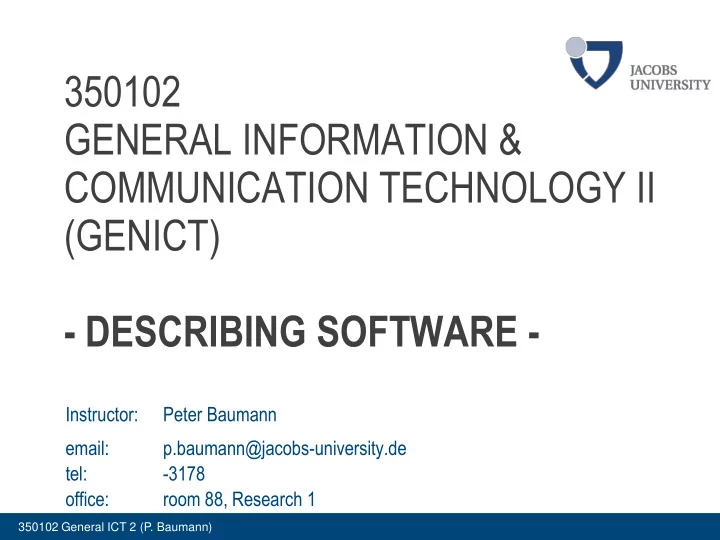

350102 GENERAL INFORMATION & COMMUNICATION TECHNOLOGY II (GENICT) - DESCRIBING SOFTWARE - Instructor: Peter Baumann email: p.baumann@jacobs-university.de tel: -3178 office: room 88, Research 1 350102 General ICT 2 (P. Baumann)
The Software Life Cycle Requirements Engineering Design Coding Configuration, Release, & Dependency Management Verification & Testing Deployment, Maintenance 350102 General ICT 2 (P. Baumann) 2
"Plan? Who needs a plan?" Introduction to UML based on: Introduction to the Unified Modeling Language , Chapter 2 Terry Quatrani, UML Evangelist, IBM Instructor: Peter Baumann email: p.baumann@jacobs-university.de tel: -3178 Excellent work! But maybe we office: room 88, Research 1 should get a little more detailed here...? 350102 General ICT 2 (P. Baumann)
What is UML? What is UML? • "The UML (Unified Modeling Language) is the [OMG] standard language for specifying, visualizing, constructing, and documenting all the artifacts of a software system.” • Synthesis of notations by Grady Booch, Jim Rumbaugh, Ivar Jacobson, and many others • Rational, Objectory, et al, ...now IBM diagram perspectives • Conceptual, specification, implementation 350102 General ICT 2 (P. Baumann) 4
Diagram Types Overview Main diagram types, according to „80/20 rule“: • Use Case Diagram (functional) • Activity / Action Diagram (behavioral) • Class Diagram (structural) • State Diagram (behavioral) • Sequence Diagram (behavioral) Further, not addressed here: • Object Diagram (structural), Collaboration Diagram (structural), Package Diagram (structural), Deployment Diagram (structural) • Interaction Diagram ::= Collaboration Diagram | Sequence Diagram 350102 General ICT 2 (P. Baumann) 5
Use Case Diagrams use case = chunk of functionality, not a software module • Should contain a verb in its name actor = someone or some thing interacting with system under development • Aka role in scenario Visualize relationships between actors and use cases capture high-level alternate scenarios, get customer agreement (early !) 350102 General ICT 2 (P. Baumann) 6
Sequence Diagrams Displays object interactions arranged in a time sequence Can be from user„s perspective! • good for: showing what‟s going on and driving out requirements when interacting with customers How many SDs? Rule of thumb: • for every basic flow of every use case for high-level, risky scenarios • Useful for designer and customer to answer the question: „ what objects and interactions will I need to accomplish the functionality specified by the flow of events? “ 350102 General ICT 2 (P. Baumann) 7
Activity Diagrams Represents the overall flow of control Graphical workflow of activities and actions • like flow chart, but user-perceived actions (business model) Swimlanes Synchronisation bar (fork/join) Transition guard 350102 General ICT 2 (P. Baumann) 8
Class Diagrams Class = collection of objects with common structure, common behavior, common relationships, and common semantics Displayed as box with up to 3 compartments: • Name • List of attributes (aka state variables) • List of operations Class modeling elements include: • Classes with structure + behavior Relationships • • Multiplicity and navigation indicators • Role names 350102 General ICT 2 (P. Baumann) 9
Class Diagrams: (Instance) Relships Models that two objects can “ talk ” Association – bi-directional connection between classes • “I can send you a message because if I‟m associated with you, I know you‟re there .” Aggregation – stronger form: „ has a“ how • R. between a whole and its parts described? Dependency – weaker form • “ need your services, but I don‟t know that you exist .” Quatrani : „ typically first make everything an association, lateron refine “ 350102 General ICT 2 (P. Baumann) 10
Class Diagrams: Multiplicities, Navig. Multiplicity numbers & intervals denote number of instances that can/must participate in relationship instance • For both ends of relationship edge • 0..1 (may have one) • 1 (must have one) • 0..* or * (may have many) • 1..* (has at least one) Arrow head to denote: traversable only this direction 350102 General ICT 2 (P. Baumann) 11
Class Diagrams: Inheritance Inheritance = relation between sub class and super class Subclass instances have • all properties specified in superclass • plus the specific ones defined with the subclass Also called „is - a“ 350102 General ICT 2 (P. Baumann) 12
Ready? Let‘s go! Trike Different types of vehicles Family [motorbike-search-engine.co.uk] 350102 General ICT 2 (P. Baumann) 13
Activity vs Sequence Diagrams? Activity diagram: Sequence diagram: Granularity: user-perceived actions Granularity: actors + system components How do actors interact? How do components interact? 350102 General ICT 2 (P. Baumann) 14
Warehouse Management [interopporesearch.blogspot.com] 350102 General ICT 2 (P. Baumann) 15
Ready? Let‘s go! Customer / waiter / chef 350102 General ICT 2 (P. Baumann) 17
UML python class Box class Box: Box def __init__(self,w,h) self.width = w - width :float self.height = h - height :float def area(self) + init(float, float) :void return self.width + area() :float * self.height 350102 General ICT 2 (P. Baumann) 18
Particularities of python Properties are simply used, without declaration Inheritance indicated after class name • Ex: class B(A) means „B in herits from A“ Private items start with „__“ (2x underscore) • Ex: __myPrivateValue Builtin methods for object maintenance • Ex: __new__() , __del__() , __repr__() , plus many more • Other languages, such as C++, offer default constructors, copy constructors, destructors 350102 General ICT 2 (P. Baumann) 19
Wrap-Up UML industry standard for visually describing all aspects during software life cycle • Use Case Diagram, Activity Diagram , Sequence Diagram, Class Diagram, State Diagram, ... We had but a primer – UML spec has ~1,000 pages... More work in the beginning (= before coding starts), but will pay off in • Better design (less flaws & more consistency) • Fewer costly surprises late at integration / customer testing time • Better plannable • Higher customer satisfaction, better career 350102 General ICT 2 (P. Baumann) 20
Recommend
More recommend